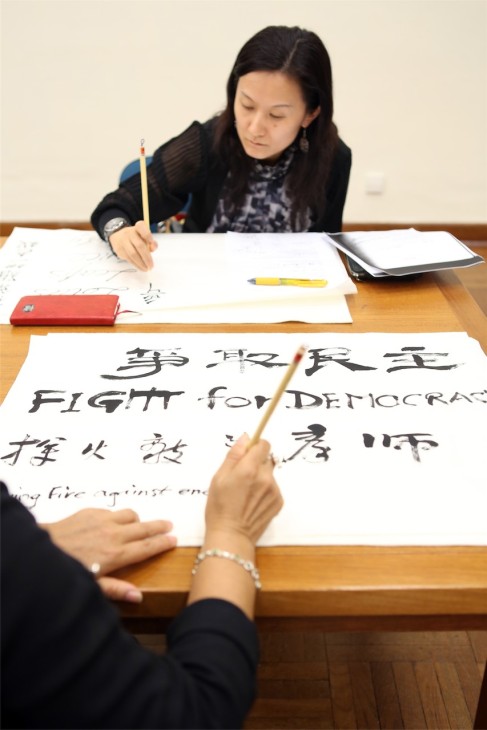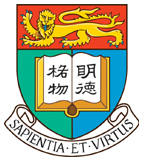Many thanks to all of you who took part in the workshop on Wednesday October 17th. We collected many excellent contributions. I hope you all enjoyed the opportunity to meet with Gu. Here are a few photos from that evening.
How can I take part?
Gu Wenda’s collaborative work at HKU will be based on the poetic scrambling of language he devised for his installation ‘Forest of Stone Steles: Retranslating Tang Poetry’ (see link here). But instead of having Gu himself supply the words, we are inviting all current and former students of HKU to provide your own poetic mistranslations, based on your time at HKU and your thoughts and feelings about our University.
When we have gathered all the submissions together, every participant will be invited to take part in an art workshop with Gu at the start of the 2012 Autumn semester, to write out the phrases you have devised in pen and ink. All of your contributions will then be bound into a book, which will be accessioned into the University’s collections, and placed on display to commemorate HKU’s centennial. Gu will also select examples of your calligraphy for inclusion in an artwork which will be placed on display in the Centennial Campus, as a memento of Gu’s visit, and of the University’s centennial.
How to participate
First, you will need to devise the phrase you would like to write out calligraphically. Gu’s procedure for doing so is set out in this downloadable pdf.
The procedure for HKU differs slightly. It can be broken down into the following steps:
1. Select your phrase.
Pick a phrase that communicates something you feel is significant about HKU. It can be written in Chinese or English; you can pronounce it in Cantonese, Putonghua, or however you prefer. Phrases tend to lengthen as you translate them, so you may prefer to pick something brief.
For example, let us pick a phrase that resonates with the University:
學習
2. Translate your phrase, literally, into English (or Chinese) as you see fit. For example, 學習 can be translated as “to learn and practice”.
3. Now, transliterate your Roman letters into Chinese characters (or vice-versa) phonetically, according to their sound, but in a way that still forms a coherent Chinese sentenc. So, for example, “to learn and practice” could be rendered as 圖樂呢暗被替思 with one Chinese character corresponding to each syllable of the English phrase. Using other homonyms you could, of course, arrive at a different result.
4. Translate your chinese sentence back into English. In this case, one possible translation would be “What about the search for joy? You thoughts would obscurely be substituted.”
Since we are not concerned here with correct translation, you have a lot of freedom, not only in selecting your phrase, but in how you interpret words and sounds at every stage. The most important thing is to end up with a phrase that you find suggestive, interesting, or resonant.
Once you have devised your phrase, send it, along with all the steps from 1 through 4 to the following e-mail address: guwenda@hku.hk. Similarly, if you have any questions or suggestion, please send them to this e-mail address.
Filed under Uncategorized
About Gu Wenda
Gu Wenda, born in 1955 in Shanghai, graduated from the China Academy of Arts in Hangzhou in 1981, and has been based in the USA since 1987. He is one of the pioneers of Chinese contemporary art, and has produced a distinguished body of work that has been displayed and exhibited at a wide range of prominent international values.
Gu’s work often draws on traditional forms, materials and techniques associated with China’s cultural identity and with its past, such as ink, tea, seals, engraved steles, landscape painting, and paper lanterns. By taking recognisable materials and giving them unrecognisable forms; dislocating and enlarging traditional objects; or juxtaposing signs of Chinese and non-Chinese culture, Gu has produced work that perpetuates China’s traditional arts, while simultaneously exploring the meanings of those traditions in a modern and interconnected world. He is, for this reason, an especially fitting artist to commemorate the centenary of the University of Hong Kong, a place were diverse cultural and scholarly traditions coexist and interact.
Since very early in his career, Gu has demonstrated a pronounced interest in language, and in its written and visual representation – in particular, by Chinese ideographs. In the 1980s, he presented exhibitions of seemingly traditional ideographs that, on closer inspection, turned out to be invented, illegible, or ‘false’. Gu has periodically returned to the use of ideographs to explore the intersection of novelty, tradition, meaning and identity.
In 1993, Gu began a project entitled ‘Forest of Stone Steles: Retranslation & Rewriting Tang Poetry’ which he exhibited in Hong Kong in 2004, and in Xi’an in 2005. ‘Forest of Stone Steles’ is a meditation on the interpretation and interpenetration of cultures. The installation comprises rows of steles engraved with Chinese characters. To obtain these inscriptions, Gu selected lines of Tang poetry, translated them literally into English, then transliterated the sound of the English words into Chinese characters. For example, 月光 is translated into English as moon light, which, transliterated into Chinese characters, becomes 虻癩忒 (mang lai te), a phrase which signifies horsefly leprosy error. By combining sequences of ‘incorrectly’ translated poetry, Gu transformed canonical Tang poems into sequences of uncanny verbal images. The resulting characters were then engraved onto steles in traditional calligraphic styles, a form that evokes the antiquity and longevity of Chinese history and culture, now bearing meanings that have been filtered and transformed through another language, and through contemporary ways of manipulating poetic idioms.
‘Forest of Stone Steles’ will form the basis of Gu’s collaborative work with students and alumni in HKU. You can see pictures, and read a fuller description of this installation at Gu Wenda’s website (under Image Galleries/Installation). You can also download a pdf describing it here.
Filed under Uncategorized





